ABSTRACT
Most of the apples consumed across Nigeria are imported from South Africa, Europe and United States of America. Despite the epicuticular hydrophobic wax naturally produced by the fruit which makes it resistant to external spoilage factors, extra coating is usually employed by producers for protection against biotic and abiotic attack during storage in order to extend shelf-life. Nowadays, Nigerians have raised concerns on the nature, level and safety of these wax coatings in apples available in Nigerian market. The results of organoleptic, physicochemical and Fourier transfer infrared spectroscopy (FTIR) analyses suggested that the epicuticular waxes of apples in Abuja markets are mainly from petrochemical sources with adulterants from waxes of vegetable sources or beeswax. The mineral concentration of Cu, K, Mg, Mn, Zn and Pb in waxes per average sized apples (mg/g) ranged from 1.73 to 15.66, 10.80 to 1357, 26.46 to 173.12, 0.11 to 0.22, 2.05 to 41.80 and 3.78 to 11.66 mg/g, respectively. The results indicated hundred (100%) of the samples contained copper (0.02 mg/g) and zinc (0.05 mg/g), and sixty percent (60%) contained lead above WHO permissible limit (0.01 mg/g). It is however recommended that the layer of coating should be to reduce apple growers or sellers to the barest minimum to avoid over-coating and the amount of waxes consumed per apple. Waxes can be removed from apple by dipping the apple in hot water for a few seconds to remove the wax or washing with pure white vinegar and rinsing in warm water.
Key words: Apples, waxes, beeswax, paraffin wax, mineral, Fourier transfer infrared spectroscopy (FTIR).
The fruit of Malus pumila Mill, also known as Malus sylvestris L. (Mill.) var. Domestica Borkh (Rosaceae) commonly known as Apple, sold and consumed in FCT-Abuja and other parts of Nigeria are mostly not home-grown. The unfavourable tropical climatic conditions make their domestication in the country difficult. South Africa is a major supplier of apples particularly to the Federal Capital Territory, Abuja. Some sources are as far as the United States of America and New Zealand among others (Foraminifera Market Research, 2018). The outer layers of aerial morphological parts of plants especially fruits are coated with a hydrophobic layer called epicuticle wax (Müller and Riederer, 2005). The epicuticular wax served various functions particularly as a shield to provide water repellence, prevent moisture loss due to uncontrolled non-stomatal long-term storage, and loss of organic and inorganic compounds by leaching. It served as a protective covering against abiotic and biotic environmental stresses; mechanical damage, abrasions; attack and infection by plant pathogens such as fungi and insects (Bringe et al., 2006) and also against absorption of fertilizers, growth regulators, fungicides, insecticides and herbicides. Thus, making a significant influence on the production, storage and processing of the apples (Bajwa and Sandhu, 2014). Components of the fruit cuticle included a structural matrix known as cutin which is composed primarily of hydroxyl-and hydroxyepoxy-fatty acids and waxes, which consisted of homologous series of long-chain aliphatic compounds, including fatty acids, aldehydes, primary and secondary alcohols, ketones, alkanes and alkyl esters. Triterpenoids especially ursolic acid, have also been reported (Jetter and Schaffer, 2001; Buschhaus and Jetter, 2011).
The quantity and quality of the naturally produced epicuticular wax may be affected by environmental factors. Therefore, organic commercial waxes are sometimes added to augment the fruit natural waxing covering and to improve attractiveness. Such organic commercial waxes include shellac wax, carnauba wax or a combination of the two, resins, paraffin wax, bees wax, jojoba wax, soybean gum, and many others (Thompson, 2003; Syed et al., 2004; El-Anany et al., 2009; Hassan et al., 2014). The tendency of overloading the body with some of these chemicals which are required by the body (K, Mg, Cu, Mn, and Zn) and the toxic one (Pb) through food consumption is certain if caution is not taken, knowing that the body requirement of the necessary minerals has been established (DRI, 2011; Shaffer, 2019). The need for continual check of every consumable food or other related products which might have a direct or indirect link to human health is therefore, important. According to the USA department of Agriculture, freshly plucked hard apples will barely last 2 weeks before rotting. Hence, the study aimed at evaluating the physicochemical properties, elemental profile and characteristics of the epicuticlar wax present on the outer layer of apple fruits present in Nigeria’s’ market using Abuja as a case study.
All reagents used were of analytical grade and obtained from stock available at the National Institute for Pharmaceutical Research and Development (NIPRD) laboratory. Other materials used for the sample preparation were heating mantle (Model: Gallenhamp, Germany), glass funnel, volumetric flask (50 ml), digestion tube (100 ml), filter paper (Whatman; Size 110 mm), Micropipette (Model: perfect choice, sizes 200 µl and 0-1000 µl), sample bottles (50 ml) and Flame Atomic Absorption Spectrophotometer (Model: GBC Avanta, version 2.0, USA) at NIPRD, and FTIR (model Agilent carry 360, USA).
Sample collection and preparation
Apples sold in leading consumer stores and grocery markets in Abuja, the Federal Capital Territory, were randomly obtained and categorized into nine (9) groups based on brand name and source. Eight (8) of the groups were for the eight clearly branded apples and sourced from leading stores. The last group was for randomly selected unbranded apples from the local markets at Zuba, Kubwa, Karmo and Mararaba. The apples were packed in labelled sealable bags and coded “A” to “I” based on brand and/or source of purchase. A minimum of Ten (10) samples per group were obtained and immediately processed. Epicuticular coating from each apple was manually scrapped using hand protective coverings and new razor blades, into petri dishes.
Determination of physicochemical properties
Identification tests for solubility, taste and odour were carried out using standard methods as described by European Pharmacopoeia (2005). Commonly used and available waxes such as beeswax, white and yellow soft paraffin were used as references.
Beeswax
Isopropyl alcohol (50 ml) was added to 0.2 - 1 g of beeswax/ epicuticular waxes and dissolved by warming to 65°C in a water bath. 5 ml of warm water (35°C) was added under stirring (European Pharmacopoeia, 2005). The formation of white flocculent substances depicted the presence of beeswax.
White and yellow soft paraffin
Wax (2 g) was melted at 45°C to obtain a homogeneous phase after which 2 ml of distilled water and 0.2 ml of 0.05 M iodine was added. Mixture was shaken and allowed to cool (European Pharmacopoeia, 2005). The solid upper layer is violet-pink. Samples from apples were treated as above.
Fourier transfer infrared spectroscopy (FTIR)
A little quantity of each sample was directly analyzed using Agilent carry 360 FTIR Spectrometer by Attenuated Total Reflection (ATR) compressed KBr disk method. The samples were scanned within the range of 4000.00 to 650.00 cm-1 at resolution 8 cm-1.
Atomic absorption spectroscopy (AAS)
Stock solutions of Cu, K, Mg, Mn, Pb and Zn at 1000 µg/ml in 5% nitric acid (HNO3) were used in the preparation of the standard curve. A concentrated solution of HNO3 was used for the sample digestion. The instrument operating condition as stated in Table 1 was used for the elemental analysis and the data obtained were processed according to the methods described by Samali et al. (2017).
Waxes are very similar in physicochemical characteristics and are usually very difficult to distinguish. However, based on the analytical study, some inferences could be made as to the origin or the presence and level of non-edible minerals in them (Bajwa and Sandhu, 2014). Tables 2 and 3 depicted the results of physicochemical properties of the sample. An average of 0.22 mg of waxes per gram of apple was observed.
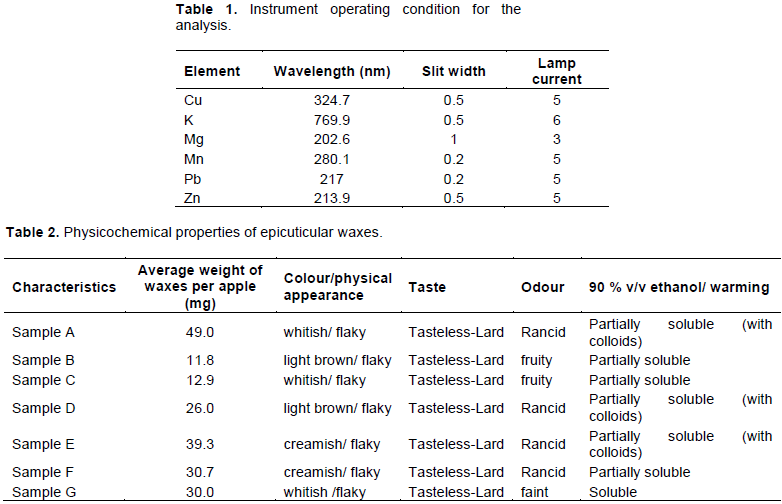

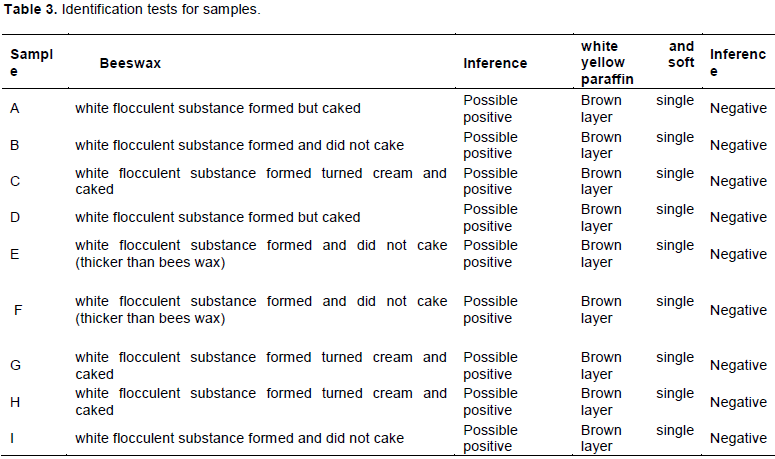
The physicochemical properties of the epicuticular wax samples from different sources A-I showed similar solubility properties depicting that they were insoluble in aqueous solvent and soluble in a more non polar solvent xylene than DCM and is partially soluble despite warming in alcohol as seen in Table 3. Identification tests showed more similarities with beeswax; however, results showed the absence of white and yellow soft paraffin. All the epicuticular waxes showed a positive result to the presence of terpenes (purple/blue colour). The plates also showed that the samples were neither beeswax nor white soft paraffin.
FTIR spectra analysis
The results of FTIR analysis (Figure 1) showed that all the samples had major peaks at 2918, 2851, 1465 and 736 or 724 cm-1. The major peak at 2918 and 2851 cm-1 corresponds to stretching vibration of sp2 hybridized C-H bond or methylene C-H of saturated aliphatic or alicyclic compounds. The strong methylene/methyl bending vibration at 1465 cm-1 and the weak symmetric methyl C-H band at 1380 cm-1 in addition to the major band at 736 or 724 cm-1 (methylene rocking vibration, n ≥ 3) is indicative of a long-chain linear aliphatic structure. The very weak peaks at 1033-978 cm-1 are due to methylene C-H of cyclohexane ring, which may be from the solvent of extraction. Since splitting did not occur at 1465 and 724 cm-1, as predictable for branched chains, the linearity and unbranched nature is further confirmed. There was no terminal vinyl or pendant vinylidene C-H stretching (3100-3000 cm-1) or bending (1420-1290 cm-1), and the absence of C=C stretch at 1680-1600 cm-1 confirms the absence of unsaturation. No aromatic CH usually at 890-820 cm-1 was observed.
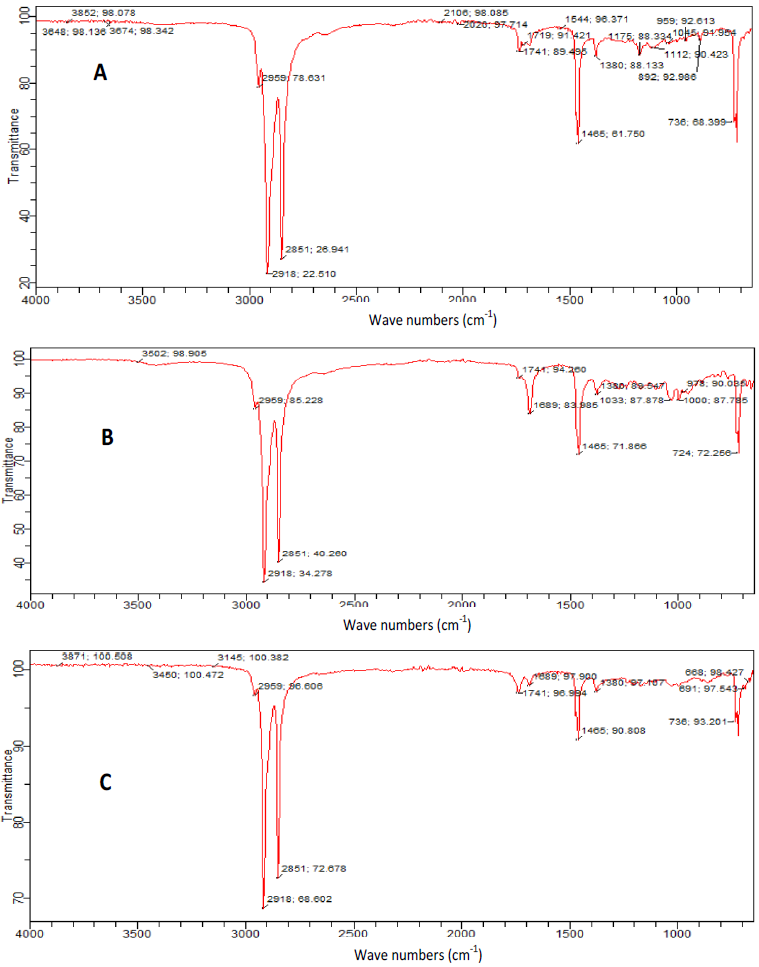
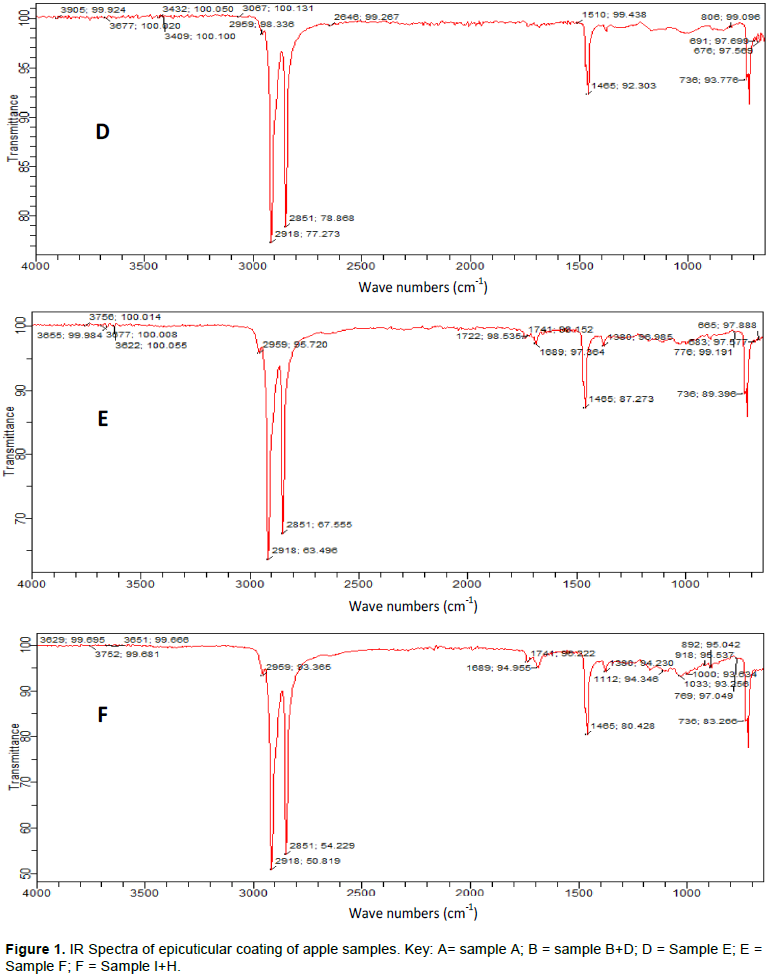
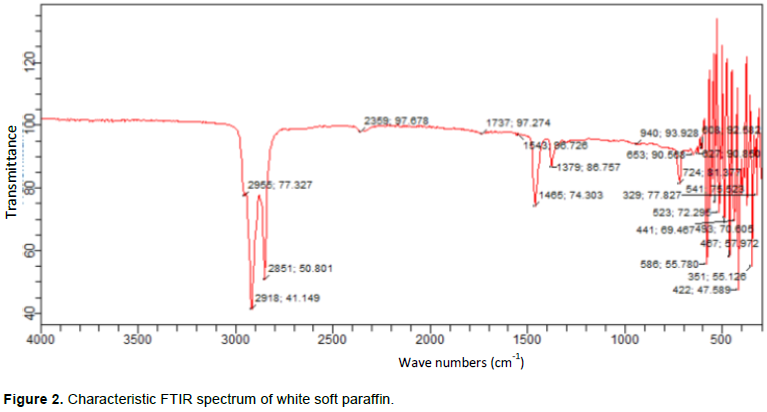
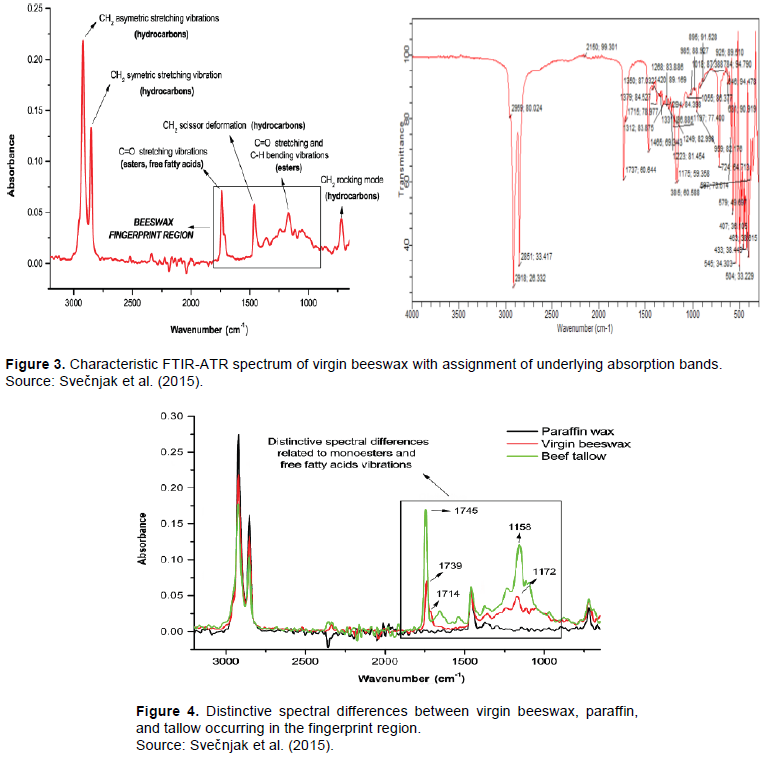
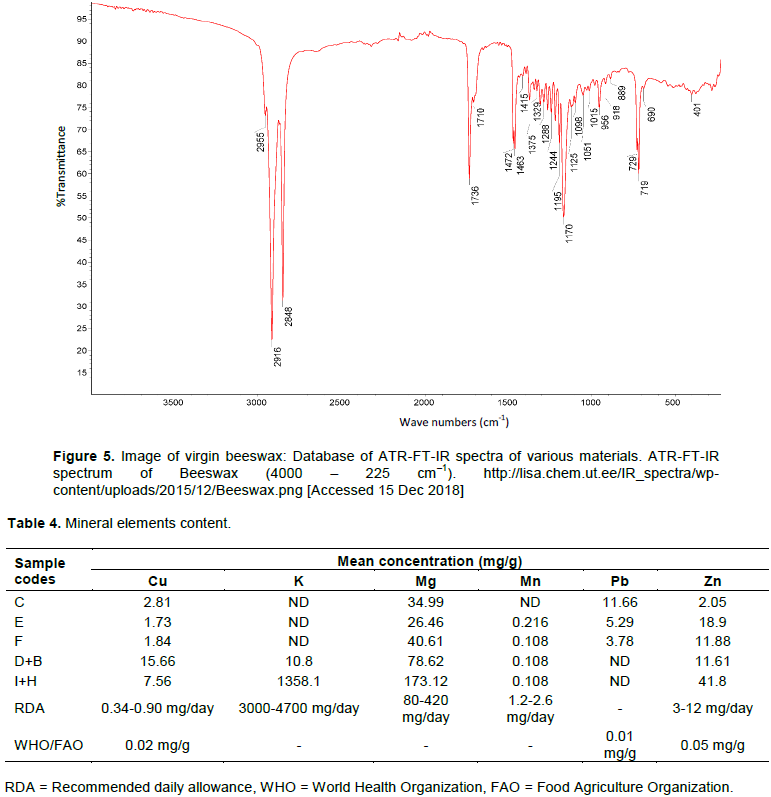
The results of analysis of waxes used in the preservation of apples imported into Nigeria, suggested that, the waxes are from petrochemical origin with some level of contamination with beeswaxes or vegetable waxes. It also indicated high level of contamination of the waxes with copper, zinc and lead above WHO/FAO permissible limits. The tendency of contamination of these waxes with other waxes and chemical preservatives like insecticides and fungicides used in orchards or farmlands against agricultural pest is possible; therefore quality of waxes used in foods and cosmetics should be monitored especially with regard to origin and mineral element content, as well as quantity applied. The food-grade waxes which are edible and safe allowed by US FDA for coating apples and other fruits are food grade petroleum jelly, beeswax and vegetable waxes such as shellac, carnauba and others, any waxes other than these may not be easily absorbed by the body and can be harmful for the colon or the small intestine. Apples that have been treated must be labelled: “coated with food-grade vegetable, beeswax, or shellac-based wax to maintain freshness”. It is therefore, pertinent to adhere to food-grade waxes for preservation of apples and other related fruits. In Nigeria, you may not always be sure that the wax used for coating the apple you buy, is food-grade and safe. It is recommended to get rid of the waxes from the apples and other related fruits before consumption.
The authors have not declared any conflict of interests.
REFERENCES
|
Ali MF, Abbas S (2006). A review of methods for the demetallization of residual fuel oils. Fuel Processing Technology 87:573-584.
Crossref
|
|
|
|
Al-Zubaidi AB, Abas OF, Abass RA, Abdulredhi NJ (2016). Thermal behaviour of paraffin wax / polyvinyl alcohol composite material. Al-Khwarizmi Engineering Journal 12(2):18-26.
|
|
|
|
|
Bajwa U, Sandhu K (2014). Effect of handling and processing on pesticide residues in food- a review. Journal of Food Science and Technology 51(2):201-220.
Crossref
|
|
|
|
|
Bringe K, Schumacher CFA, Schmitz-Eiberger M (2006). Ontogenic variation in chemical and physical characteristics of adaxial apple leaf surfaces. Phytochemistry 67:161-170.
Crossref
|
|
|
|
|
Buschhaus C, Jetter R (2011). Composition differences between epicuticular and intracuticular wax substructures: how do plants seal their epidermal surfaces? Journal of Experimental Botany 62:841-853.
Crossref
|
|
|
|
|
Coates J (2000) Interpretation of Infrared Spectra: A Practical Approach. In: Meyers, R.A., Ed., Encyclopaedia of Analytical Chemistry, John Wiley & Sons Ltd., Chichester pp. 10881-10882.
|
|
|
|
|
Dietary Reference Intakes (DRI) (2011). Recommended Dietary Allowances and Adequate Intakes, Element; Food and Nutrition Board, Institute of Medicine, National Academies pp. 1-8.
|
|
|
|
|
El-Anany AM, Hassan GFA, Rehab AFM (2009). Effects of edible coatings on the shelf-life and quality of Anna apple (Malus domestica Borkh) during cold storage. Journal of Food Technology 7:5-11.
|
|
|
|
|
European Pharmacopoeia (2005). European Pharmacopoeia Monographs. EDQM Publication (European Directorate for the Quality of Medicines and Health Care).
|
|
|
|
|
Foraminifera Market Research (2018). Apple importation, storage and distribution in Nigeria, the feasibility report. Available at:
View
|
|
|
|
|
Hassan ZH, Lesmayati S, Qomariah R, Hasbianto A (2014). Effects of wax coating applications and storage temperatures on the quality of tangerine citrus (Citrus reticulata) var. Siam Banjar. International Food Research Journal 21(2):641-648.
|
|
|
|
|
Jetter R, Schäffer S (2001). Chemical composition of the Prunus laurocerasus leaf surface. Dynamic changes of the epicuticular wax film during leaf development. Plant Physiology 126:1725-1737.
Crossref
|
|
|
|
|
Müller C, Riederer M (2005). Plant surface properties in chemical ecology. Journal of Chemical Ecology 31:2621-2651.
Crossref
|
|
|
|
|
Pavan B, Gardey L (2019). Determination of nickel and lead in wax samples by ICP-MS. Impactanalytical.com, 1940 N. Stark Rd., Midland, MI 48642, 855.IA.
|
|
|
|
|
RESCOLL (2011). Chemical characterization of waxes. Available at:
View [Accessed 15 Dec 2018].
|
|
|
|
|
Samali A, Mohammed MI, Ibrahim MB, Gamaniel KS (2017). Metal content determination of some sexual dysfunction medicine samples in Northern Nigeria. Bayero Journal of Pure and Applied Sciences 10(1):234-238.
Crossref
|
|
|
|
|
Schooley T, Weaver MJ, Mullins D, Eick M (2008). The history of lead arsenate use in apple production: Comparison of its impact in Virginia with other States. Journal of Pesticide Safety Education 10:22-52.
|
|
|
|
|
Shaffer C (2019). Macro-minerals and Trace minerals in the diet. News -medical.
|
|
|
|
|
SveÄnjak L (2015). Beeswax adulteration issue: aspects of contamination and outcome. Available at:
View [Accessed 15 Dec 2018]
|
|
|
|
|
SveÄnjak L, Baranović G, Vinceković M, PrÄ‘un S, Bubalo D, Gajger IT (2015). An approach for routine analytical detection of beeswax adulteration using FTIR-ATR Spectroscopy. Journal of Apicultural Science 59(2).
Crossref
|
|
|
|
|
Syed MS, Syed ZA, Abida A (2004). Effect of chemical treatment, wax coating, oil dipping and different wrapping materials on physico-chemical characteristics and storage behaviour of apple. Pakistan Journal of Nutrition 3(2):122-127.
Crossref
|
|
|
|
|
Thompson K (2003). Fruit and Vegetables: Harvesting, Handling and Storage, 2nd ed. of Postharvest Technology of Fruits and Vegetables, Oxford: Blackwell P 287.
Crossref
|
|
|
|
|
WHO/FAO (2001). WHO/FAO Food Addictive Data System. Evaluation by the Joint WHO/FAO Expert Committee on Food Additives 1956 - 1984. FAO Food and Nutrition, Paper 30/Review, Rome pp. 2-51.
|
|